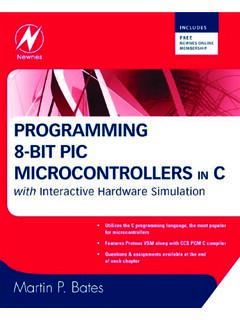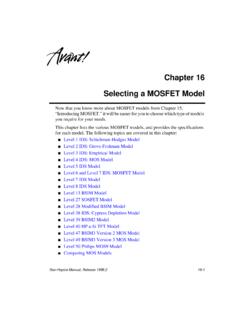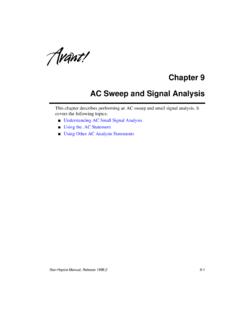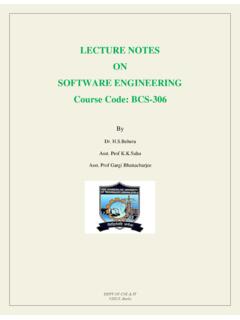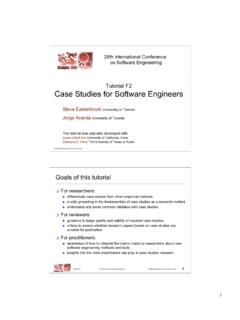Transcription of Embedded System Design: A Unified Hardware/Software …
1 Embedded System Design: A Unified hardware /SoftwareApproachFrank Vahid and Tony GivargisDepartment of Computer Science and EngineeringUniversity of CaliforniaRiverside, CA version, Fall 1999 Copyright 1999, Frank Vahid and Tony GivargisPrefaceThis book introduces Embedded System design using a modern approach. Moderndesign requires a designer to have a Unified view of software and hardware , seeing themnot as completely different domains, but rather as two implementation options along acontinuum of options varying in their design metrics (cost, performance, power,flexibility, etc.).Three important trends have made such a Unified view possible. First, integratedcircuit (IC) capacities have increased to the point that both software processors andcustom hardware processors now commonly coexist on a single IC.
2 Second, quality-compiler availability and average program sizes have increased to the point that Ccompilers (and even C++ or in some cases Java) have become commonplace inembedded systems. Third, synthesis technology has advanced to the point that synthesistools have become commonplace in the design of digital hardware . Such tools achievenearly the same for hardware design as compilers achieve in software design : they allowthe designer to describe desired processing in a high-level programming language, andthey then automatically generate an efficient (in this case custom- hardware ) processorimplementation. The first trend makes the past separation of software and hardwaredesign nearly impossible. Fortunately, the second and third trends enable their unifieddesign, by turning Embedded System design , at its highest level, into the problem ofselecting (for software ), designing (for hardware ), and integrating focuses on design principles, breaking from the traditional book that focuseson the details a particular microprocessor and its assembly-language programming.
3 Whilestressing a processor-independent high-level language approach to programming ofembedded systems, it still covers enough assembly language programming to enableprogramming of device drivers. Such processor-independence is possible because ofcompiler availability, as well as the fact that integrated development environments(IDE s) now commonly support a variety of processor targets, making such independenceeven more attractive to instructors as well as designers. However, these developmentsdon t entirely eliminate the need for some processor-specific knowledge. Thus, a coursewith a hands-on lab may supplement this book with a processor-specific databook and/ora compiler manual (both are typically very low cost or even free), or one of manycommonly available "extended databook" processor- specific describes not only the programming of microprocessors, but also the design ofcustom- hardware processors ( , digital design ).
4 Coverage of this topic is made possibleby the above-mentioned elimination of a detailed processor architecture study. Whileother books often have a review of digital design techniques, ESD uses the new top-downapproach to custom- hardware design , describing simple steps for converting high-levelprogram code into digital hardware . These steps build on the trend of digital design booksof introducing synthesis into an undergraduate curriculum ( , books by Roth, Gajski,and Katz). This book assists designers to become users of synthesis. Using a draft ofESD, we have at UCR successfully taught both programming of embeddedmicroprocessors, design of custom- hardware processors, and integration of the two, in aone-quarter course having a lab, though a semester or even two quarters would bepreferred.
5 However, instructors who do not wish to focus on synthesis will find that thetop-down approach covered still provides the important Unified view of hardware includes coverage of some additional important topics. First, while the needfor knowledge specific to a microprocessor s internals is decreasing, the need forknowledge of interfacing processors is increasing. Therefore, ESD not only includes achapter on interfacing, but also includes another chapter describing interfacing protocolscommon in Embedded systems, like CAN, I2C, ISA, PCI, and Firewire. Second, whilehigh-level programming languages greatly improve our ability to describe complexbehavior, several widely accepted computation models can improve that ability evenfurther. Thus, ESD includes chapters on advanced computation models, including statemachines and their extensions (including Statecharts), and concurrent programmingmodels.
6 Third, an extremely common subset of Embedded systems is control includes a chapter that introduces control systems in a manner that enables thereader to recognize open and closed-loop control systems, to use simple PID and fuzzycontrollers, and to be aware that a rich theory exists that can be drawn upon for design ofsuch systems. Finally, ESD includes a chapter on design methodology, includingdiscussion of Hardware/Software codesign, a user s introduction to synthesis (frombehavioral down to logic levels), and the major trend towards Intellectual Property (IP)based materials: A web page will be established to be used in conjunction withthe book. A set of slides will be available for lecture presentations. Also available foruse with the book will be a simulatable and synthesizable VHDL "reference design ,"consisting of a simple version of a MIPS processor, memory, BIOS, DMA controller,UART, parallel port, and an input device (currently a CCD preprocessor), and optionallya cache, two-level bus architecture, a bus bridge, and an 8051 microcontroller.
7 We havealready developed a version of this reference design at UCR. This design can be used inlabs that have the ability to simulate and/or synthesize VHDL descriptions. There arenumerous possible uses depending on the course focus, ranging from simulation to seefirst-hand how various components work in a System ( , DMA, interrupt processing,arbitration, etc.), to synthesis of working FPGA System will likely want to have a prototyping environment consisting of amicroprocessor development board and/or in-circuit emulator, and perhaps an FPGA development board. These environments vary tremendously among , we will make the details of our environments and lab projects available on theweb page. Again, these have already been 1: IntroductionEmbedded System design , Vahid/Givargis Last update: 09/27/99 2:51 PM1-1 Chapter 1 Embedded systems overviewComputing systems are everywhere.
8 It s probably no surprise that millions ofcomputing systems are built every year destined for desktop computers (PersonalComputers, or PC s), workstations, mainframes and servers. What may be surprising isthat billions of computing systems are built every year for a very different purpose: theyare Embedded within larger electronic devices, repeatedly carrying out a particularfunction, often going completely unrecognized by the device s user. Creating a precisedefinition of such Embedded computing systems, or simply Embedded systems, is not aneasy task. We might try the following definition: An Embedded System is nearly anycomputing System other than a desktop, laptop, or mainframe computer. That definitionisn t perfect, but it may be as close as we ll get. We can better understand such systemsby examining common examples and common characteristics.
9 Such examination willreveal major challenges facing designers of such systems are found in a variety of common electronic devices, such as: (a)consumer electronics -- cell phones, pagers, digital cameras, camcorders, videocassetterecorders, portable video games, calculators, and personal digital assistants; (b) homeappliances -- microwave ovens, answering machines, thermostat, home security, washingmachines, and lighting systems; (c) office automation -- fax machines, copiers, printers,and scanners; (d) business equipment -- cash registers, curbside check-in, alarm systems,card readers, product scanners, and automated teller machines; (e) automobiles --transmission control, cruise control, fuel injection, anti-lock brakes, and activesuspension. One might say that nearly any device that runs on electricity either alreadyhas, or will soon have, a computing System Embedded within it.
10 While about 40% ofAmerican households had a desktop computer in 1994, each household had an average ofmore than 30 Embedded computers, with that number expected to rise into the hundredsby the year 2000. The electronics in an average car cost $1237 in 1995, and may cost$2125 by 2000. Several billion Embedded microprocessor units were sold annually inrecent years, compared to a few hundred million desktop microprocessor systems have several common characteristics:1) Single-functioned: An Embedded System usually executes only oneprogram, repeatedly. For example, a pager is always a pager. In contrast, adesktop System executes a variety of programs, like spreadsheets, wordprocessors, and video games, with new programs added ) Tightly constrained: All computing systems have constraints on designmetrics, but those on Embedded systems can be especially tight.
